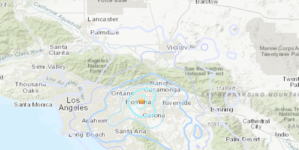-
Initial reactions to USMNT’s disappointing loss to Canada | SOTU - 16 mins ago
-
Bet365 Bonus Code WEEK365: Choose $200 Bonus or $1K Safety Net for NFL - 28 mins ago
-
Northern Illinois stuns No. 5 Notre Dame 16-14 with field goal in final minute - about 1 hour ago
-
FanDuel Promo Code: New NFL Bettors Get $200 Bonus, Sunday Ticket Deal - about 1 hour ago
-
Jennifer Lopez, Matt Damon clasp hands during ‘long, deep conversation’ at ‘Unstoppable’ afterparty: report - about 1 hour ago
-
Jesse Marsch: ‘Rather coach Canada than U.S. right now’ - 2 hours ago
-
Active Shooter on I-75 in Kentucky, Numerous Victims Reported - 2 hours ago
-
With Bulls’ Lonzo Ball Hoping For 2024-25 Comeback, Nikola Vucevic Weighs In - 2 hours ago
-
Michigan State vs. Maryland Highlights | FOX College Football - 2 hours ago
-
National Gallery of Art set to open “Paris 1874: The Impressionist Movement” - 3 hours ago
California heat wave likely a preview of what’s to come this summer
After months of below-average temperatures and weeks of unseasonably wet weather, California’s first heat wave of the year is marking an abrupt transition into summery heat, with record-breaking, triple-digit temperatures expected this week.
The next few days — particularly Wednesday and Thursday — could offer a preview for the summer season, which is expected to bring higher temperatures than typical across the state’s interior — creating potentially dangerous conditions for both human health and wildfire management.
“We can definitely expect a warm summer as a whole,” said Brian Adams, a National Weather Service meteorologist in San Diego. There’s a strong chance for above-average temperatures statewide through at least August, including during much of June, according to the latest models from the National Weather Service’s Climate Prediction Center.
This week, the state’s inland communities will feel the most intense temperature spikes from the high pressure ridge, or heat dome, parked over California, while the coast will be largely unaffected — a strong “June gloom” still providing refuge from the heat.
“It’s the marine layer, that’s nature’s air conditioning and this is the peak of it,” said Ryan Kittell, a National Weather Service meteorologist in Oxnard. “There’s a lot of moderation from that heat due to that marine layer. … It’s a real steady increase [in temperature] as you go further inland.”
Kittell said the extent and length of Southern California’s marine layer will slowly start to diminish as the heat wave progresses, with Los Angeles County valleys seeing more sunshine by Thursday and Friday afternoon. But overall, the moist, low clouds will keep temperatures across much of the Southland near normal for this time of year.
Temperatures Wednesday and Thursday are expected to peak around 70 degrees at L.A. County beaches, hit the mid-70s in downtown L.A. and reach the 80s and low 90s in the valleys, Kittell said — about 5 to 10 degrees warmer than Monday, but only slightly above average for this time of year.
“We’ll never fully shake the marine layer clouds,” Adams said. “This time of year [the marine layer is] a big part of why we’re relatively spared along the coast,” a phenomenon that will be less likely when a heat wave hits in July or August.
But moving inland, a dramatic climb on the mercury is forecast for the majority of the state, with temperatures expected over 100 from Redding down to Bakersfield. Across most of interior Northern California through the southern San Joaquin Valley, officials are warning of a major heat risk Wednesday and Thursday, a level considered “dangerous to anyone without proper hydration or adequate cooling,” according to the National Weather Service. The major heat risk also extends across the Mojave Desert through Friday.
MAJOR HeatRisk is expected throughout much of interior NorCal today-Thurs. This level of heat is dangerous to anyone w/o proper hydration or adequate cooling. Remember to stay hydrated & reconsider outdoor activities during the hottest parts of the day (3-7PM). #CAwx pic.twitter.com/EFcCTXHkZr
— NWS Sacramento (@NWSSacramento) June 4, 2024
National Weather Service officials are newly highlighting the serious and potentially deadly health effects from extreme heat, which is becoming more frequent and turbulent because of human-caused climate change. The agency’s urgent warnings focus primarily on vulnerable populations, such as newborns, children, the elderly, and those pregnant or with chronic illnesses, reminding residents to stay hydrated, avoid the heat of the day and use air conditioning.
Gov. Gavin Newsom announced Tuesday that the state had activated part of its Extreme Temperature Response Plan, triggered by weather service advisories, which “moves the state into action to coordinate an all-hands response by the state government,” the governor said in a press release. The plan includes tracking and sharing available cooling centers and promoting safety tips and resources.
“Everywhere will see noticeable warming, but the most significant and potentially hazardous heat will be … inland,” Kittell said.
In Southern California, the Antelope, Coachella, Apple and Lucerne valleys will see the most intense temperatures, with highs expected between 100 and 113 Wednesday, Thursday and Friday.
“It’s roughly 10 to 15 degrees above average,” Adams said, noting that this time of year typically brings temperatures in the high 80s or 90s across the Southern California deserts.
Weather officials upgraded the Antelope Valley and its surrounding foothills to an excessive heat warning for Wednesday and Thursday, advising that temperatures up to 107 degrees are possible as are “warm overnight low temperatures,” which don’t allow for much recovery at night. The Apple and Lucerne valleys are under a similar advisory, with temperatures up to 106 degrees possible.
“Those temperatures are almost typical for the hottest part of the year out there in the desert, but for early June, it’s abnormal,” Kittell said. “The same temperatures in August, we wouldn’t be warning people about it … [but now] there’s been less time to get acclimated.”
Lancaster and Palmdale are both forecast to break daily high temperature records Thursday at 105 degrees; both cities have historical highs on June 6 at 103 degrees, according to the weather service.
Farther east, even more intense heat Thursday could also set records, with Death Valley National Park expected to tie its daily historical high at 121 degrees; Needles, close to the Arizona border, could slip past its June 6 record if it hits 115 degrees as forecast; and Bishop, south of Mammoth Lakes, could surpass its record by 2 degrees with its forecasted 104-degree high, according to the National Weather Service in Las Vegas.
Across the San Bernardino and Inyo county deserts, an excessive heat warning is cautioning about “dangerously hot conditions for early June” from Wednesday through Friday. Temperatures are expected to hit 116 degrees around Lake Mead and Lake Havasu City, 114 degrees in the Morongo Valley and up to 122 degrees in Death Valley — highs that have all inched higher since prior forecasts.
“As the heat builds day by day there will be little relief during the overnights, especially within the Las Vegas valley and Death Valley National Park,” the warning said.
The San Joaquin Valley is also under an excessive heat warning from Wednesday through Friday, with highs from 103 to 108 expected and the possibility for several cities to break or tie some daily records. Fresno is likely to break its historical June 6 high by 1 degree, with its high Thursday forecast at 108 degrees, while Madera could tie its record of 107 degrees. The Mojave Desert and Indian Wells Valley has been warned to brace for highs up to 111 degrees.
In Northern California, the heat wave began warming the region Tuesday, with excessive heat warnings in effect through Thursday for the Sacramento Valley and Sierra foothills. Highs there were forecast to reach 95 to 108 degrees. Across inland North and East Bay, as well as into the Salinas Valley and the Sonoma County mountains, highs were expected to reach nearly 100 degrees Tuesday, Wednesday and Thursday, according to the heat advisory issued for that region.
“There is a moderate to high risk for those who are heat sensitive, especially those without effective cooling or adequate hydration,” the National Weather Service Bay Area warned.
Even the Eureka office of the National Weather Service warned of moderate heat risk as far north as Trinity County, where interior valleys could reach 100 to 105 degrees Wednesday and Thursday.
The hot and dry conditions have raised concerns about fire risk across the state, though officials still say the state’s particularly wet winter will continue to delay the start of the most dangerous wildfires.
“We had a lot of rain over the winter, and the bigger fuels — the trees and the shrubs — are still pretty moist,” Kittell said. “Those finer fuels [mostly grasses], … they’ve dried out a lot and we’ve already seen significant grass fires.”
Earlier this week, a grass fire broke out in San Joaquin County outside of Tracy.
Firefighters battled the 14,000-acre fire fueled by dry grasses, and crews reported it 90% contained by early Tuesday, according to the California Department of Forestry and Fire Protection. Several other small fires have occurred throughout the state, including two vegetation fires in Santa Barbara County and one in Riverside County.
“It’s mainly going to be a grass fire concern for the next one or two months,” Adams said. Such fires don’t tend to burn as hot as those involving larger plants.
Source link
























